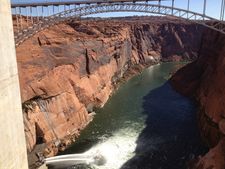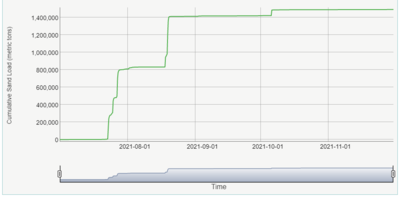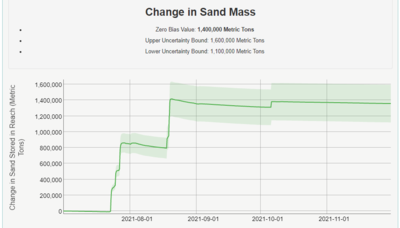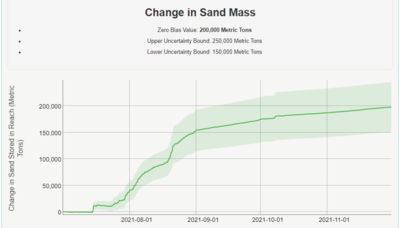A 2021 Fall HFE
| High Flow Experiment- 2021 | |
 |
Contents
[hide]2021 Fall High Flow Experiment Snapshot
The Leadership Team has reviewed and considered the PI Team’s recommendation, including the assessment of key resources that may be impacted or affected by a 60-hour fall HFE. The Leadership Team met via webinar on September 29, 2021 and, consistent with the PI Team’s recommendation, members were divided in their assessment of a 60-hour fall HFE. The 2021 water year was an historically difficult year for the Western states, including tribes, fisheries, wildlife, farmers, ranchers, and communities. The Colorado River Basin is experiencing its 22nd year of drought and many years of low-runoff conditions. Following two extremely dry periods of runoff in 2020 (54% of average annual inflow) and 2021 (33% of average annual inflow), the two reservoirs (Lake Mead and Lake Powell) are at their lowest levels since they were originally filled. The Colorado River Drought Contingency Plan Authorization Act (P.L. 116-14) directs Interior to “operate Colorado River reservoirs” according to Drought Contingency Plan agreements, including the Drought Response Operations Agreement (DROA), which establishes an objective for Glen Canyon Dam operations to minimize the risk of falling below a “Target Elevation” of 3525 feet (ft). The potential effect of a HFE on the Target Elevation is an appropriate consideration when determining whether to conduct a HFE.
As a response to the hydrologic conditions and the need to protect critical levels at Lake Powell as part of the DROA, Reclamation began releasing water from upper reservoirs to Lake Powell in July under the Emergency Action provisions of DROA. These releases from upper reservoirs are to help reduce the risk of Lake Powell going below the DROA-identified Target Elevation of 3525 ft. These DROA actions will continue through the calendar year. While these actions have helped to reduce the risk for next year, it is likely that additional actions may or will be needed to protect critical levels.
The sediment triggers outlined by LTEMP ROD have been met to consider a 2021 fall HFE. Advocates for the 2021 fall HFE are concerned that the ability to implement HFEs in the future may be limited, should drought conditions continue. They also cite the much-needed sediment resource benefits from a fall HFE given that it has been three years since the most recent HFE (fall 2018) was triggered and implemented. Implementation of a fall HFE would not impact the annual release volume from Lake Powell, which is set at 7.48 maf in WY 2022. Due to relatively low winter flows, sandbar increases would be retained through winter such that the 60- hour fall HFE would result in a net 20% increase to sandbar size in April 2022 relative to October 2021.
The majority of Leadership Team members indicated that one or more of the following concerns amount to unacceptable adverse impacts on resource areas as identified for consideration by the LTEMP ROD.
Implementation of a 60-hour fall HFE would temporarily reduce Lake Powell reservoir elevation by approximately 2 feet, which reduction is contrary to the objective of an approximately 3 feet of elevation increase made possible due to additional releases from upper basin initial units (Flaming Gorge, Navajo, and Aspinall) currently being implemented under the DROA. As a result, Leadership Team members have indicated that implementation of a fall HFE in November 2021 may result in reduced support for future drought response operations—which releases will likely be necessary to avoid the water elevation dropping below 3,525 at Lake Powell. Further, under most probable hydrology a 60-hour fall HFE is projected to result in up to 15 additional days below 3,525 ft and an annual minimum elevation 0.7 ft lower than if no HFE were to be implemented. While these impacts to reservoir elevation could be mitigated by reallocation (reducing) releases in December, January, and February rather than March, April, and May, doing so would result in a greater direct cost to the Basin Fund for purchase power. The current condition and projections for the Basin Fund have elicited unprecedent actions by WAPA and Reclamation including deferred maintenance, a proposed rate increase, elimination of certain firm supply provisions in contracts, and a one-time pursuit of appropriations for environmental program base funding. The proposed HFE would worsen the condition of the Basin fund; direct costs to the Basin Fund are estimated at $1.30M for March, April, May reallocation and at $3.04M for December, January, February reallocation. The majority of Leadership Team members indicated that one or more of these concerns amount to unacceptable adverse impacts. Based on the concerns expressed by both the Leadership Team and the PI Team, the determination of unacceptable adverse impacts, and the lack of consensus to implement a 60- hour fall HFE, I concur with the determination of unacceptable adverse impacts and I have decided not to conduct a fall HFE in November 2021. We will continue to work with our partners in future HFEs and in the protection of the Grand Canyon and our most important resources. (1)
Sediment Conditions
Fall Accounting Period- Paria input (Jul 1 to Nov 30): 1,492,000 mt
- Evacuated from Upper Marble Canyon (Jul 1 to Nov 30, lower bound) = 1,100,000 mt
- Evacuated from Lower Marble Canyon (Jul 1 to Nov 30, lower bound) = 150,000 mt
- Available for Fall HFE: 1,642,000 mt
SUPPORTING DOCUMENTS
- Technical recommendation report and decision memo
- Fall 2021 HFE - Decision Memo
- FINAL Tech Team Report - Fall 2021 HFE Recommendation
- The sand is there, but low water levels halt a controlled flood to restore Grand Canyon's beaches
- A Letter to Mr. Wayne Pullan, Glen Canyon Dam Adaptive Management Program Designee for the Honorable Deb Haaland, Secretary of the Interior: 27 October 2021
COMPLIANCE
CONCERNS
The PI Team has worked over the past several weeks to evaluate existing data and coordinate the potential implementation of an HFE. The PI Team evaluated the latest data from agency experts, and considered multiple issues in making its recommendation, as summarized below. The PI Team arrived at this recommendation after several weeks of PI Team conference calls, and after receiving feedback from Adaptive Management Program stakeholders. The Secretary of the Interior and/or her Designee will consider the recommendation of the PI Team, but retains sole discretion to decide how best to accomplish operations and experiments in any given year pursuant to the 2016 LTEMP ROD and other binding obligations for Glen Canyon Dam. The PI Team incorporated the most current science and data and considered multiple issues with agency experts, as summarized below, in making this final recommendation.
192-hour Extended Duration Fall HFE
The PI Team arrived at this recommendation after several weeks of PI Team conference calls, and after receiving feedback from Adaptive Management Program stakeholders. By consensus, the PI Team is opposed to recommending that the Department implement a 192-hour extended duration HFE in fall 2021. The PI Team identified the following resource concerns associated with a 192-hour extended duration fall HFE: challenges and risks associated with reallocating a large volume of water (415 kaf) while meeting hourly, daily and monthly operating objectives identified in the LTEMP ROD and consistent with a 7.48 maf annual release pattern; uncertainties and risks associated with exacerbating low reservoir elevations (e.g. additional days below 3,525 ft, lower annual minimum); the strain on the already low status for the Basin Fund as projected by WAPA; and potential impacts to non-native fish, including increased brown trout immigration to Lees Ferry and increased risk of fish entrainment at lower reservoir elevations. PI Team members highlighted uncertainties regarding Glen Canyon Dam’s ability to reliably and effectively deliver water and generate power when pool elevation drops below 3,525 ft. Further, a highly anticipated spring HFE, if triggered, would be prohibited from occurring in the same water year as an extended duration HFE.
60-hour Fall HFE
Technical representatives were divided in the assessment of a shorter duration 60-hour HFE, having evaluated the alternative for its ability to reduce negative resource impacts while still providing sufficient benefit to the sediment resource in terms of learning and effectiveness. The majority of representatives on the PI Team are opposed to recommending that the Department implement a 60-hour HFE this fall, several members support recommending that the Department implement a 60-hour duration HFE this fall, and two members (WAPA and AGFD) have abstained from making a recommendation. PI Team representatives opposed to a 60-hour HFE include all seven Basin States (AZDWR, CA, CO, NM, UT, WY, NV), UCRC, and Reclamation. Those opposed to implementing a shorter duration HFE this fall indicated that the reduced duration did not sufficiently address all unacceptable adverse impacts to resources identified above (low pool elevation, Basin Fund status). They also expressed concern that potential benefits to the sediment resource would not outweigh potential adverse impacts. PI Team members again highlighted uncertainties regarding Glen Canyon Dam’s ability to reliably and effectively deliver water and generate power when pool elevation drops below 3,525 ft.
Those that support or that do not oppose implementation of a 60-hour HFE include BIA, NPS, USGS, and USFWS. PI Team members in favor of an HFE cited the much-needed sediment resource benefits from a fall HFE and included this option as a potential compromise for the Leadership Team to consider that addresses both concerns expressed while still providing benefits to sediment (predicted +30% sandbar size in November 2021 relative to October 2021). They also noted that, in LTEMP, fall HFEs were predicted to be conducted frequently (~3 out of every 4 years) and it has been three years since the most recent HFE (fall 2018) was triggered and implemented, such that this HFE would rebuild some of the beaches that were lost during this time. GMCRC noted that sandbar benefits from a 60-hour HFE would likely be greater in Marble Canyon, but would result in sandbar deposition throughout Marble Canyon and Grand Canyon. It was noted that maintaining camping beaches is important for the LTEMP sediment resource goal. Also noted is the potential for improved legacy of sandbar increases resulting from a fall HFE (predicted +20% sandbar size in April 2022 relative to October 2021) due to relatively low winter flows consistent with the 7.48 maf annual release pattern planned for Lake Powell in Water Year (WY) 2022. The GCMRC highlighted the learning value of implementing an HFE in November 2021 in that it would contribute to addressing, 1) the long-term question about the cumulative effect of multiple HFEs over the 20-year period of the LTEMP, and 2) questions about the potential combined effects of HFEs and riparian vegetation management for sand storage in aeolian dunefields covering archaeological sites. Although the best available science indicates a fall HFE may result in small benefits to undesired non-native species, these effects were highly uncertain (see rainbow trout section below) or the marginal impact was expected to be small (see brown trout section). Thus, expert opinion among fishery biologists was that a 60 hour fall HFE would not substantively increase risk to endangered and native fishes in Grand Canyon above the existing level of risk. (2)
Stakeholder Concerns: A Letter to Mr. Wayne Pullan, Glen Canyon Dam Adaptive Management Program Designee for the Honorable Deb Haaland, Secretary of the Interior: 27 October 2021
We, the undersigned, work through our organizations and governments to ensure the ecological, cultural, and recreational integrity of the Colorado River ecosystem (CRE) as stakeholders in the Glen Canyon Dam Adaptive Management Program (AMP). We greatly appreciate the collaborative, science-based approach of the AMP to management of the Colorado River ecosystem (CRE) influenced by Glen Canyon Dam through Glen and Grand Canyons. We thank the AMP for its recent high flow experiment (HFE) informational report [Final Recommendation Regarding a Fall 2021 High Flow Experiment (HFE) at Glen Canyon Dam, November 2021, dated September 28, 2021] and the informational session provided by Reclamation and the AMP Planning and Implementation (PI) Team, which decided against conducting an autumn 2021 HFE. We also appreciate the discussion held through the Technical Work Group (TWG) on 14 October 2021. However, we wish to express our concern with several issues surrounding this decision process.
- AMP Tribal, environmental, and recreational stakeholders were not involved in the final decision on the potential for a 2021 HFE. To more fully realize the goals of the 1992 Grand Canyon Protection Act, we call on the AMWG to address the inequalities of stakeholder representation on the PI Team, and to support greater transparency in its decision-making. Our contributions and perspectives were not represented in this decision, and we feel we have been disenfranchised from this decision process. While we do not necessarily disagree with the PI Team’s decision, we wish to be involved, and not excluded from, these important decisions in the future. Consequently and collectively, we request that the AMWG include all AMP stakeholder voices in such decisions, thereby moving towards the kind of consensus that is core to its role in advising the Secretary. If inclusion of our voices can only be achieved through a National Environmental Policy Act process, we request that the Secretary consider including our voices on the PI Team during the AMP’s next NEPA-related effort.
- Depletion of the Basin Fund was one of the primary reasons that the 2021 HFE was denied, yet future funding for the AMP is to come from appropriated funds, thus not draining the Basin Fund. Therefore, this reason for denying an HFE does not appear to be valid. Furthermore, we question the merit of a decision-making process wherein the Basin Fund’s fiscal health outweighs the multiple benefits of an HFE on the CRE’s ecological, cultural, and recreational resources. Most troubling, the HFE Informational Report recognizes the poor condition of the Basin Fund now and well into the future, regardless of whether an HFE is conducted or not. We are deeply concerned that this focus on the Basin Fund establishes a rationale and precedent to prohibit HFE’s in the future.
- We have additional concerns about the precedent set by the decision to forego a 2021 HFE. In 2021 the Paria River delivered the second highest amount of sand since recording began, exceeding the sediment trigger for an HFE. The CRE is now primed for an HFE to store that sediment at higher elevations, replenishing the now-depleted shallow shoreline habitats and camping beaches that support native fish and recreational camping, respectively. Sedimentological data provided by the USGS Grand Canyon Monitoring and Research Center supports this conclusion. Furthermore, with low flows likely for the next two or more years, the benefits of a winter 2021 or a springtime 2022 HFE would be long-lasting. Ultimately, we are concerned that the precedent set by the decision to forego an HFE is based primarily on considerations put forth by power generation and water interests, and that the mandates of the 1992 Grand Canyon Protection Act were insufficiently weighed in this decision. We believe that a more balanced approach that gives equal weight to all valued resources can be achieved without undue strain on important water and power resources.
- We are further concerned that the AMP is insufficiently flexible in its adaptive management capacity: the AMP needs to be able to accommodate unforeseen but advantageous changes that arise. Predictions about how much snow will fall in the Rocky Mountains this coming winter are highly speculative, but the PI Team decision did not reflect consideration of contingencies. For example, above-normal winter flows should promote consideration of a springtime HFE. If flows are normal or slightly below average, a within-powerplant high flow (such as that conducted in March 2021) might be feasible. But if winter inflows are below normal, then a high flow may be precluded, despite the depleted condition of many Grand Canyon camping beaches. Unfortunately, the PI Team’s decision apparently did not consider such options. This issue of administrative flexibility is important in adaptive management, and is in keeping with Dr. Petty’s memorandum, encouraging the AMP to include both flow and non-flow management options in its recommendations to the Secretary. Adaptive CRE management demands such flexibility, as opportunities for improving resource stewardship may arise unexpectedly.
- Lastly, the LTEMP sediment accounting periods have long been recognized as inadequate for the task of adaptive CRE management, a problem that constrains achievement of AMP goals. The present winter and springtime accounting periods preclude sufficient sediment from accruing in the channel to allow for a springtime HFE. This occurs despite the fact that natural historical floods occurred during springtime, and CRE species and processes are adapted to those springtime spates. CRE shorelines and sandbars benefit most from springtime high flows by rejuvenating camping beaches and shoreline habitats just prior to the onset of summer native fish spawning and recreational uses, respectively. The AMP has been repeatedly briefed by GCMRC and several stakeholders on the need and importance of seasonally appropriate, sediment-triggered HFEs, but the AMWG has not acted adaptively to rectify this error in the LTEMP. Therefore, we request that the AMWG include this subject in its next meeting, and provide adequate time for a discussion to explain, work to resolve, and adaptively rectify this impediment within the LTEMP. We comment on the above issues to help ensure that the AMP and the Secretary continue to respect, incorporate, and benefit from the perspectives of all of its stakeholders. We intend to continue to work together to ensure consensus on adaptive management issues and help the AMP make the best science-based recommendation to the Secretary.
Signatories to this Letter:
- Kelly Burke, Executive Director of Grand Canyon Wildlands Council
- David Brown, Grand Canyon River Guides
- Peter Bungart, Hualapai Tribe
- Daniel Bulletts, North Kaibab Paiute Tribe
- Kevin Dahl, NPCA
- Sinjin Eberle, American Rivers
- Lynn Hamilton, Executive Director of Grand Canyon River Guides Association
- William Persons, Trout Unlimited, Fly Fishers international (Recreational fishing)
- Ben Reeder, Grand Canyon River Guides
- Matt Rice, American Rivers
- Erik Stanfield, Navajo Nation
- Larry Stevens, GCWC
- Jim Strogen, Trout Unlimited, Fly Fishers international (Recreational fishing)
ADDITIONAL
Under the 2016 Long-Term Experimental and Management Plan Record of Decision, HFE releases are triggered by substantial sediment accumulation in the Colorado River below Glen Canyon Dam. Monsoonal flooding in the Paria River near Lees Ferry moves sediment into the Colorado River, where its accumulation is carefully monitored by the U.S. Geological Survey. When implemented, high flows carry and redistribute the sediment throughout the canyon above the typical high-water mark.
Per the 2016 ROD, HFEs releases can occur either in the spring from March through June (spring HFE), or in the fall from October through November (fall HFE). If enough sediment enters the Colorado River from July to November, a fall HFEs release can be implemented. The decision to conduct a fall HFE release is usually made in October based on sediment accumulation, as well as a variety of other resource conditions.
No HFEs were conducted in calendar year 2019 or 2020, though a Spring Disturbance Flow was implemented in March 2021. The Department of the Interior conducted the most recent HFE release from Glen Canyon Dam on November 5-8, 2018. The HFE release included a peak flow of approximately 38,100 cubic feet per second for 60 hours (four days including ramping-up from baseflows to peak release) to move accumulated sediment downstream to help rebuild beaches and sandbars. This HFE release was the first to be conducted under the 2016 LTEMP HFE Protocol. Similar HFE releases were conducted in 2012, 2013, 2014 and 2016 in accordance with the 2011 HFE Environmental Assessment Protocol. The 2018 HFE release provided resource benefits and scientific information to be used in future decision making. [1]


